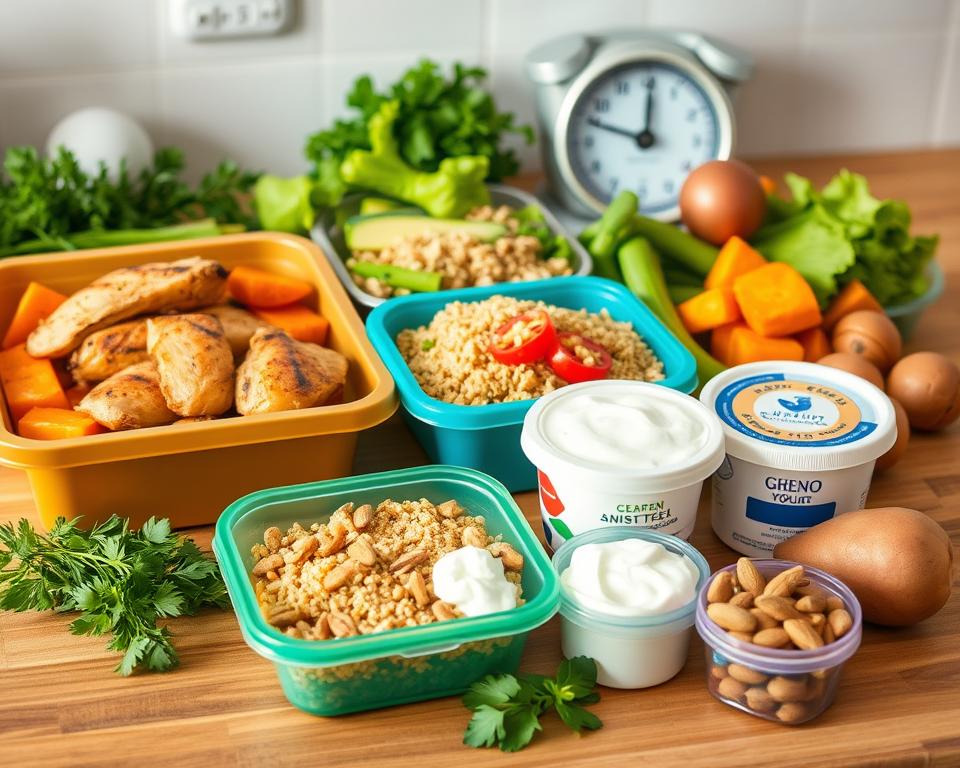Many people want to build a strong, muscular body naturally. This goal is about improving fitness and looks. It involves a mix of resistance training, good nutrition, and hard work1.
Building muscle is a big deal for those who want to look better1. The body needs to add more protein to muscles than it loses for muscle growth1. Different weight lifting reps can help with strength, muscle growth, or endurance1. People may respond differently to different rep ranges for building muscle1.
To build muscle, you need to eat 300-500 more calories daily than usual1. Eating 1.4-2 grams of protein per kilogram of body weight daily is key1. It’s important to eat enough to gain muscle without gaining too much fat1.
Compound exercises like the barbell back squat work many muscles at once1. A good workout plan includes 3 sets of 3-5 compound exercises and 3 sets of 1-2 isolation exercises1. Building muscle needs resistance training and enough protein and nutrients1. Eating foods rich in protein like lean meats, dairy, fish, and plant proteins helps grow muscles1.
Key Takeaways
- Muscle building requires a combination of resistance training and proper nutrition.
- Aim for a caloric surplus of 300-500 calories per day to support muscle growth.
- Consume 1.4-2 grams of protein per kilogram of body weight daily for optimal muscle building.
- Compound exercises that work multiple muscle groups are essential for efficient muscle development.
- A balanced diet with lean proteins, whole grains, fruits, and vegetables supports overall health and muscle growth.
Understanding Body Building Naturally
Natural bodybuilding is about getting a balanced, lean, and muscular body without steroids. It’s all about proper training, good nutrition, and patience. This way, you can get lean muscle mass gains and natural muscle growth that lasts.
The Benefits of Natural Body Building
Going natural with bodybuilding has many benefits. It boosts your health, strength, and endurance. Plus, it makes you look better in a safe way. Natural bodybuilders can build muscle without steroids but need to pay close attention to training, supplements, and diet.2
Myths vs. Facts in Body Building
Many myths say you need lots of supplements and strict diets for natural bodybuilding. But, a balanced diet and smart supplements are key for natural muscle growth. Creatine monohydrate, essential amino acids, and protein supplements are recommended for natural bodybuilders to enhance muscle gain.2
Importance of Consistency and Patience
Getting big through natural bodybuilding takes time and dedication. Progress in natural bodybuilding is a long-term process measured in months and years, not days and weeks.2 Consistent strength gains in the 6-12 rep range indicate muscle growth.2 Keeping a training journal is vital for tracking your progress and finding the best workout plans2.
The secret to natural bodybuilding success is a holistic approach. This means combining proper training, nutrition, and recovery for lean muscle mass gains and better health.
“The journey of a thousand miles begins with a single step. Embrace the process, and the results will follow.”
Setting Goals for Your Body Transformation
To achieve a successful body transformation without supplements, setting clear goals is key. For beginners in strength training, it’s important to have both short-term and long-term goals. Short-term goals help you see progress right away, like lifting more or doing more reps. Long-term goals guide you towards your bigger dreams, like reaching a certain body shape or fitness level.
Short-term vs. Long-term Goals
Short-term goals keep you motivated and track your progress. Statistics show that age milestones impact individuals’ perception of their physical health, with concerns rising significantly after the age of 40.3 The guide says it’s never too late to start improving health and fitness. Small wins can keep you excited to keep going.
Long-term goals give you a clear direction. It is noted that habit change is crucial for body transformation success, highlighting the importance of implementing sustainable lifestyle modifications.3 Having big goals, like a target weight or body fat percentage, helps you stay focused and make smart choices.
SMART Goals Framework
Using the SMART framework is key to effective goals. SMART stands for Specific, Measurable, Achievable, Relevant, and Time-bound. Encouragement is given toward setting clear, realistic goals for body transformation by dividing long-term goals into smaller, achievable milestones.3 This method helps you create a clear plan and track your progress better.
Tracking Your Progress
Tracking your progress is vital for staying motivated and adjusting your plan as needed. One of the key statistics mentioned is related to water consumption, with the fact that most people are under-hydrated and that dehydration can hinder weight loss efforts.3 The importance of mindful eating is underlined, encouraging individuals to slow down their eating pace and focus on the quality of food consumed.3 Use a mix of weight, body measurements, and performance metrics to measure your progress. Don’t forget to take before and after photos to document your journey.
Remember, setting goals for your body transformation is a crucial step. By breaking down your goals and tracking your progress, you’ll be on your way to lasting results34.
Creating a Balanced Workout Routine
Making a good workout plan means mixing different types of exercises. A great plan should include strength training, cardio, and flexibility exercises. This covers all parts of fitness5.
Strength Training Basics
Strength training is key for a balanced fitness plan. It includes compound exercises that work many muscles at once and isolation exercises for specific muscles. Do 3 sets of 3-5 compound exercises and 1-2 isolation exercises per session5.
The number of reps matters too. Use 1-5 reps for strength, 8-12 for muscle growth, and 15+ for endurance5.
Cardiovascular Exercises for Fat Loss
Cardio is important for losing fat and keeping your heart healthy. The Department of Health and Human Services says adults should do 150 minutes of moderate cardio or 75 minutes of vigorous cardio weekly6. For weight loss, aim for 300 minutes of aerobic activity weekly6.
High-intensity interval training (HIIT) is a quick way to do cardio. It involves short, intense workouts followed by rest6.
Flexibility and Mobility Work
Adding flexibility and mobility exercises to your routine is crucial. Stretching can make your joints more mobile, improve your posture, and boost blood flow5. Hold stretches for 30 seconds after warming up or exercising6.
Balance training is also vital. It improves your balance, strengthens stabilizer muscles, and sharpens your reaction time5.
By mixing strength training, cardio, and flexibility, you can make a complete fitness routine. This routine will help you reach your health and fitness goals5.
| Exercise Type | Recommended Frequency | Benefits |
|---|---|---|
| Strength Training | 2-3 times per week | Builds muscle, increases bone density, boosts metabolism |
| Cardiovascular Exercise | 150-300 minutes per week | Improves heart health, aids in weight management, reduces disease risk |
| Flexibility and Mobility | Daily, 30 seconds per stretch | Enhances range of motion, improves posture, reduces injury risk |
“A balanced workout routine is the key to achieving your fitness goals and maintaining a healthy, strong body.”
Essential Nutrition for Building Muscle
Proper nutrition is key for building and keeping lean muscle. Knowing about macronutrients, micronutrients, and staying hydrated helps your body build muscle well.
Macronutrients Explained
Protein is the main part of muscle tissue. Experts say you should eat 1.4–2 grams of protein for every kilogram of your body weight each day to build muscle7. Foods like chicken, tuna, soybeans, cottage cheese, and turkey are high in protein and help meet your needs7.
Carbohydrates give your muscles the energy they need to perform well. The International Society of Sports Nutrition (ISSN) says eating 45–55% of your daily calories as carbs is good for fitness8. Good carb sources include cooked quinoa, brown rice, and buckwheat.
Fats are important for muscle health and recovery. The ISSN suggests 15–20% of your daily calories should be from healthy fats. Nuts, seeds, and fatty fish like salmon are great for your diet.
The Role of Micronutrients
Micronutrients, like vitamins and minerals, are key for health and muscle function. Eating a balanced diet with fruits, vegetables, and whole grains helps you get the micronutrients you need for muscle building.
Iron is important for muscle building, and soybeans are a good source of it7. Calcium and magnesium are also important for muscle contraction and recovery.
Hydration’s Impact on Performance
Drinking enough water is vital for muscle performance and recovery. Dehydration can make it hard to exercise well and slow down muscle growth. Drink plenty of water, especially before and after working out, to help your muscle-building efforts.
“Nutrition is the foundation for building muscle. By focusing on quality protein, complex carbs, and healthy fats, you can support your body’s natural muscle-building process.”
Meal Planning for Muscle Gain

Proper meal planning is key for building lean muscle. During bulking, you aim to eat about 15% more calories9. In the cutting phase, you cut calories by 15%9. It’s important to keep a balanced diet, with 30-35% calories from protein, 55-60% from carbs, and 15-20% from fat9.
Sample Meal Plans for Different Goals
Meal planning is vital, whether bulking or cutting. Experts say eat 10% to 20% more calories than needed for weight gain10. Aim for 1.6 to 2.2 grams of protein per kilogram of weight daily10. Eat 0.4 to 0.55 grams of protein per meal10. Keep fat intake moderate at 0.5 to 1.5 grams per kilogram10. Carbohydrates should be 3.5 to 5 grams per kilogram10.
Tips for Meal Prep
Batch cooking and using storage containers make meal planning easier. This helps stick to your muscle-building nutrition plan. Avoid fatty, fibrous, and carbonated foods before workouts to avoid stomach issues9. Bodybuilders often use whey protein, creatine, and caffeine to aid their fitness9.
Eating for Recovery
Eating protein and carbs after workouts is vital for muscle recovery. Studies show eating 1 cup of nitrate-rich leafy greens daily boosts leg strength by 11%11. A good meal plan for muscle gain includes both animal and plant-based proteins in every meal and snack11.
Following a structured meal plan supports nutrition for muscle building and lean muscle mass gains. Adjust your calorie and macronutrient intake based on your goals and phase, whether bulking or cutting.
“Consistency and patience are key when it comes to building muscle naturally. Stick to a balanced meal plan, and you’ll be on your way to achieving your fitness goals.”
Natural Supplements to Consider
Natural bodybuilding focuses on whole foods. But, some supplements can help support your muscle-building goals. Let’s look at a few natural supplements you might find useful.
Protein Powders and Their Benefits
Protein is key for muscle growth and repair. In the U.S., many people take protein supplements. They need about 0.8 to 1.0 grams of protein per kilogram of body weight every day12. Athletes might need even more, up to twice as much, says the International Society of Sports Nutrition (ISSN)12.
Whey, casein, and soy protein are common supplements. They can help increase muscle size and strength12.
Creatine: What You Need to Know
Creatine is a top choice for boosting exercise performance. People usually take 20 grams daily for five days, then 2 to 5 grams a day12. It helps build muscle and strength in young, healthy people12.
It can raise muscle creatine levels by up to 40%13. Women have less creatine than men and metabolize it differently13.
Vitamin and Mineral Supplements
Adding vitamin and mineral supplements can fill nutritional gaps. They support health and recovery. For example, coenzyme Q10 (CoQ10) aids in muscle recovery and fights muscle loss in older adults12.
Always talk to a healthcare professional before adding supplements. Be careful, as young people are more likely to have serious side effects from muscle-building supplements12.
“Supplements can be a valuable addition to a balanced diet and training program, but they should never be a substitute for whole, nutrient-rich foods.”
Recovery Techniques to Support Growth
Reaching your fitness goals is not just about hard workouts. Rest and recovery are key for building lean muscle and staying healthy. By using smart recovery methods, you can get the most from your training and avoid overtraining.
The Importance of Sleep
Getting enough sleep is vital for muscle repair and growth. Try to sleep 7 to 9 hours each night. This helps your body fix tissues, balance hormones, and refill energy14. Good sleep also boosts your athletic and mental performance, helping you succeed in and out of the gym.
Active Recovery Strategies
Rest days are important, but active recovery helps too. Light exercises like stretching or easy cardio improve blood flow and reduce soreness15. Foam rolling and massages can also help, easing tension and speeding up recovery15.
The Role of Rest Days
Rest days are essential for muscle repair and growth16. How often and long you need them depends on your fitness, workout intensity, and recovery needs16. Paying attention to your body and adjusting your rest and recovery can prevent overtraining and help you grow stronger.
Finding the right balance between challenging and resting your body is crucial for muscle growth. Focus on sleep, active recovery, and strategic rest days. This supports your body’s natural repair and growth processes, leading to lean muscle mass gains141516.
Staying Motivated Throughout Your Journey
Keeping motivated is key to reaching your fitness goals. This is true whether you’re starting with strength training for beginners or aiming to build muscle without bodybuilding without supplements. By using strategies that keep you excited and engaged, you can reach your goals and keep the results going.
Finding a Workout Buddy
Having a workout partner can really help. They can keep you accountable and support you. Studies show that people with a workout buddy are 45% more likely to stick to their fitness goals17. You can motivate each other, celebrate successes, and get through tough times together.
Celebrating Milestones
It’s important to celebrate your progress, no matter how small. Research shows that people who celebrate their small wins are 25% more likely to stay motivated17. Celebrating your achievements, like reaching a new personal best or fitting into a smaller size, shows you the fruits of your labor and keeps you going.
Dealing with Setbacks
Setbacks are a normal part of fitness. How you handle them is crucial. Studies say setting realistic goals can make you 60% more likely to stick to your workout routine17. Also, trying different workouts can make you 30% more committed in the long run17. By adjusting your goals and strategies, you can get past obstacles and keep your motivation up.
Remember, finding what works for you is the key to staying motivated. Try different approaches, celebrate your achievements, and be flexible with your fitness journey. With dedication and hard work, you can achieve the body you’ve always wanted171819.
Avoiding Common Pitfalls

The journey of natural muscle growth is rewarding but comes with pitfalls. One major issue is overtraining, which can cause injuries and slow down muscle growth20. It’s important to listen to your body and give it enough rest. Gradually increase workout intensity and volume over time20.
Nutritional deficiencies can happen when you follow very strict diets without supplements20. To grow muscle well, eat a balanced diet. This should include protein, carbs, fats, and vitamins20.
It’s also easy to fall for quick fixes like extreme diets or unsafe supplements20. But these can be disappointing and risky for your health. Stay patient, consistent, and focus on long-term strategies for the best results.
Overtraining and Injury Risks
Overtraining is a big challenge in natural muscle growth. It happens when you push your body too hard without enough rest. This can make you perform worse, increase injury risk, and mess with hormones20. Listen to your body, increase workout intensity slowly, and rest well between sessions20.
Nutritional Deficiencies
Eating a balanced diet is key for bodybuilding without supplements. Some try extreme diets to build muscle fast, but this can lead to nutritional gaps20. Eat a variety of whole, nutrient-rich foods to support muscle repair and growth20.
The Dangers of Quick Fixes
The urge for quick results can lead to extreme diets or unsafe supplements20. These methods are often not sustainable and can harm your health and muscle-building goals20. Stay patient, disciplined, and make lasting lifestyle changes for better results.
Building natural muscle growth takes time, dedication, and a balanced approach to nutrition and training202122. Be aware of these common pitfalls and follow a well-rounded, evidence-based plan. This will set you up for long-term success in bodybuilding202122.
Building a Sustainable Lifestyle
Creating a sustainable lifestyle is key for keeping your23 lean muscle mass gains. It means fitting fitness into your daily life, like taking the stairs instead of the elevator24. It also means walking more during the day. Healthy habits help you reach your bodybuilding goals and protect the environment.
Integrating Fitness into Your Daily Life
Find ways to move more in your daily life24. Small actions, like parking further away or taking breaks to stand or walk, keep you active. Try biking or walking for errands or to work24. It’s good for the planet and your health.
Establishing Healthy Habits
Being consistent is crucial for a sustainable lifestyle. Create a workout plan that fits your schedule and eat well23 to build muscle25. Practice good posture, stretch regularly, and listen to your body. These habits improve your health and well-being.
Maintaining Balance and Enjoyment
The path to natural muscle growth is long-term, not quick23. Keep a balanced approach to enjoy the journey and avoid burnout25. Use restorative yoga or gentle walks for recovery. Make your workouts fun by trying new things or exercising with friends.
FAQ
What are the key factors for building muscle naturally?
To build muscle naturally, focus on resistance training, eating enough protein, and increasing the weight you lift. Muscle growth happens when your muscles get bigger over time.
What are the benefits of natural bodybuilding?
Natural bodybuilding boosts your health, strength, and looks. It helps you build a balanced, lean, and strong body without using drugs.
How important is consistency and patience for natural muscle growth?
Being consistent and patient is key for natural muscle growth. It takes time and dedication to see results. Stick to your workout and diet plan.
How should I set goals for my body transformation?
Setting realistic goals is crucial. Short-term goals help you see progress quickly. Long-term goals guide your journey. Use the SMART framework to make effective goals.
What are the key components of a balanced workout routine?
A good workout routine includes strength training, cardio, and flexibility exercises. Start with compound exercises like squats and deadlifts. Then, add isolation exercises like bicep curls.
What are the important macronutrient and micronutrient considerations for building muscle?
Eating right is vital for muscle growth. You need protein, carbs, and fats. Also, eat a variety of foods to get all the vitamins and minerals you need.
How should I plan my meals for muscle gain?
Planning your meals is key for muscle gain. Include protein, carbs, and fats in your diet. Use meal prep tips to make cooking easier and save time.
What natural supplements can be beneficial for muscle building?
Natural bodybuilding focuses on food, but some supplements can help. Whey protein, creatine, and caffeine are good choices. Also, consider vitamin and mineral supplements to fill any nutritional gaps.
What recovery strategies are important for muscle growth?
Recovery is essential for muscle growth. Get enough sleep, use active recovery, and take rest days. This allows your muscles to repair and grow stronger.
How can I stay motivated throughout my bodybuilding journey?
Staying motivated is vital. Find a workout buddy, celebrate your achievements, and adjust your plan if you hit a roadblock. This will keep you going.
What common pitfalls should I avoid in natural bodybuilding?
Avoid overtraining, not eating enough, and quick fixes like extreme diets or unsafe supplements. Also, stay away from alcohol, sugary foods, and fried foods.
How can I build a sustainable lifestyle for muscle building?
A sustainable lifestyle means making fitness a part of your daily life. Create healthy habits and find balance. This way, you’ll enjoy the journey and stick to it for the long haul.
Source Links
- How to Gain Muscle: Tips, Diet, and Workout Design – https://www.healthline.com/health/fitness/how-to-gain-muscle
- A Doctor’s Expert Guide to Bodybuilding Without Steroids – Dr. Charlie Seltzer — Dr. Charlie Seltzer – https://drseltzerlifestylemedicine.com/blog/bodybuilding-without-steroids
- 12 Powerful Ways to Transform Your Body at Any Age – https://bodynetwork.com/fitness-powerful-ways-transform-body-any-age/
- How to do a Complete Body Transformation in 12 Months (The 33 Steps) – Rowlett Transformation Center – https://rowletttransformationcenter.com/complete-body-transformation/
- Balance Your Exercise with a Well-Rounded Fitness Plan | PALM Health – https://www.palmhealth.com/balance-your-exercise-with-a-well-rounded-fitness-plan/
- 5 basics of a well-rounded fitness routine – https://www.mayoclinic.org/healthy-lifestyle/fitness/in-depth/fitness-training/art-20044792
- 26 Muscle Building Foods for Lean Muscle – https://www.healthline.com/nutrition/26-muscle-building-foods
- 30 muscle building foods to fuel your goals – https://www.medicalnewstoday.com/articles/muscle-building-foods
- Bodybuilding Meal Plan: What to Eat, What to Avoid – https://www.healthline.com/nutrition/bodybuilding-meal-plan
- 7-Day Muscle Gain Diet Plan: Recipes & Prep – https://www.verywellfit.com/7-day-muscle-gain-meal-plan-ideas-recipes-and-prep-6749625
- 7-Day Meal Plan to Gain More Muscle – https://www.eatingwell.com/article/8021744/meal-plan-to-gain-more-muscle/
- Supplements for Muscle Growth – https://www.verywellhealth.com/supplements-for-muscle-growth-8303073
- The Best Supplements for Muscle Growth – https://www.healthline.com/nutrition/supplements-for-muscle-gain
- 14 Tips To Maximize Muscle Recovery – https://www.healthline.com/health/muscle-recovery
- How To Help Your Body Bounce Back After a Workout – https://health.clevelandclinic.org/strenuous-workouts-try-these-6-best-recovery-tips
- Post-Workout Muscle Recovery: How to Let Your Muscles Heal and Why – https://www.everydayhealth.com/fitness/post-workout-muscle-recovery-how-why-let-your-muscles-heal/
- 10 Proven Ways to Stay Motivated on Your Fitness Journey – https://echelonfit.com/blogs/blog/10-proven-ways-to-stay-motivated-on-your-fitness-journey?srsltid=AfmBOooX7Wg2hesE1yZqB-JLGtnDuyS-IrSnYT06Box33BD2bAosSgEt
- 8 Tips for Staying Motivated on Your Fitness Journey – https://www.blenderbottle.com/blogs/health/8-tips-for-staying-motivated-on-your-fitness-journey?srsltid=AfmBOooglfXDzpmCWslkg2pL8oA3NYZDHv36NoWAHf6P4T12aRcu-adT
- Boost Motivation and Productivity: 6 Healthy Habits – https://lpsonline.sas.upenn.edu/features/6-healthy-habits-help-keep-you-motivated-and-productive
- Step-by-Step Checklist to Make Sure You Are Building Muscle | BOXROX – https://www.boxrox.com/step-by-step-checklist-to-make-sure-you-are-building-muscle/
- Building muscle with exercise: How muscle builds, routines, and diet – https://www.medicalnewstoday.com/articles/319151
- Crafting Your Muscle-Building Journey: Finding the Optimal Approach – Vitality Health Club – https://vitalityhealthclub.com.au/crafting-your-muscle-building-journey/
- 12 Ways to Live More Sustainably – https://www.biologicaldiversity.org/programs/population_and_sustainability/sustainability/live_more_sustainably.html
- 12 Sustainable Practices You Can Do at Home – https://theearthlingco.com/blogs/news/sustainable-practices-at-home
- Cultivating a Sustainable Body: Permaculture Principles Applied to Health – Heart + Bones Yoga – https://www.heartandbonesyoga.com/resources/building-sustainable-body/


